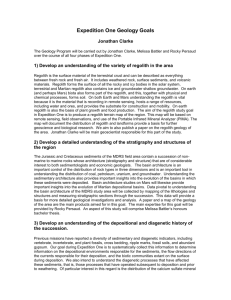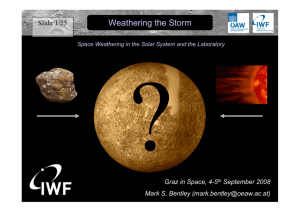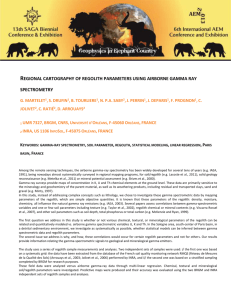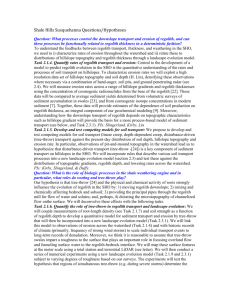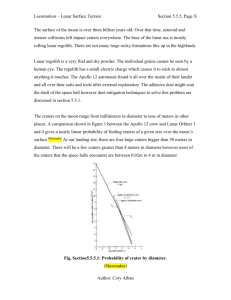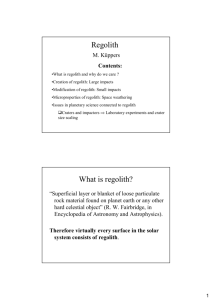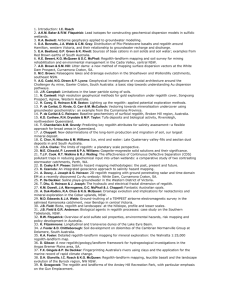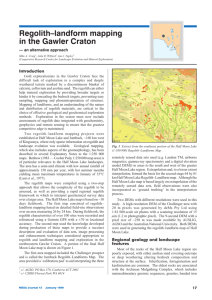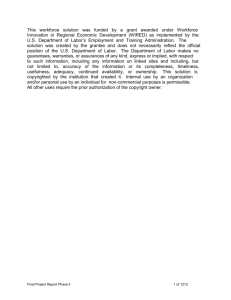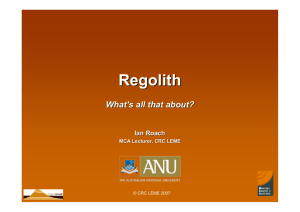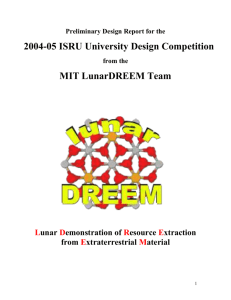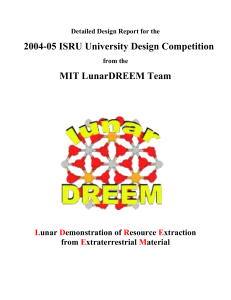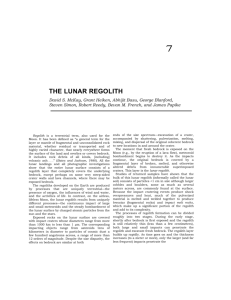TEMPERATURE OF REGOLITH IN COLD TRAPS ON THE MOON
advertisement
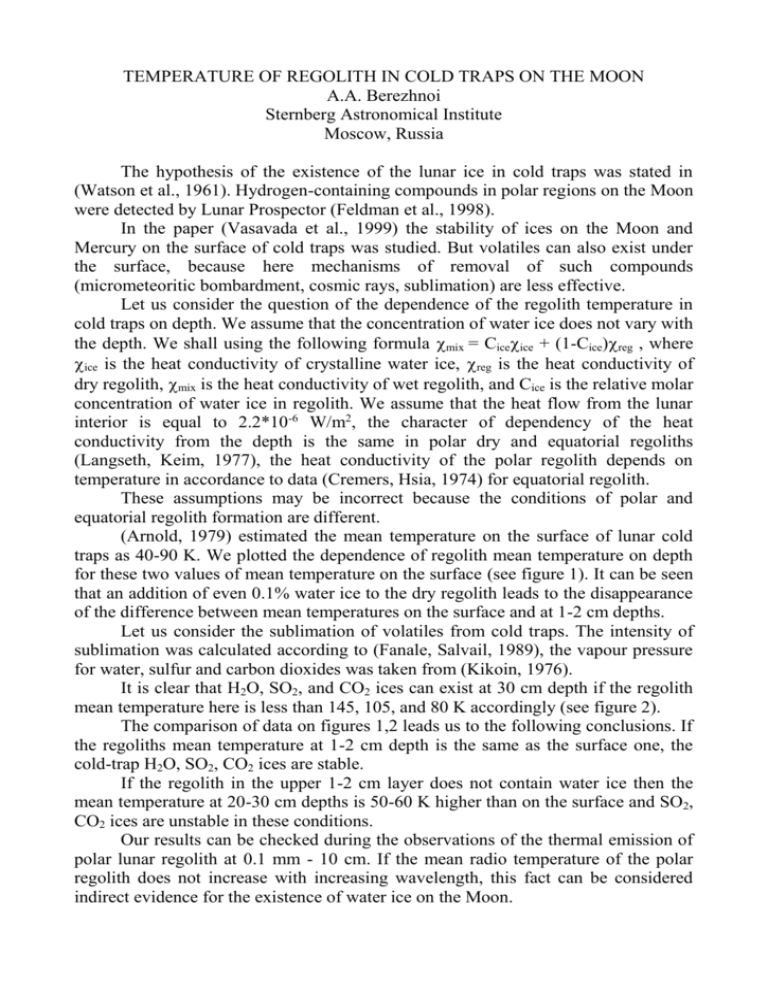
TEMPERATURE OF REGOLITH IN COLD TRAPS ON THE MOON A.A. Berezhnoi Sternberg Astronomical Institute Moscow, Russia The hypothesis of the existence of the lunar ice in cold traps was stated in (Watson et al., 1961). Hydrogen-containing compounds in polar regions on the Moon were detected by Lunar Prospector (Feldman et al., 1998). In the paper (Vasavada et al., 1999) the stability of ices on the Moon and Mercury on the surface of cold traps was studied. But volatiles can also exist under the surface, because here mechanisms of removal of such compounds (micrometeoritic bombardment, cosmic rays, sublimation) are less effective. Let us consider the question of the dependence of the regolith temperature in cold traps on depth. We assume that the concentration of water ice does not vary with the depth. We shall using the following formula mix = Ciceice + (1-Cice)reg , where ice is the heat conductivity of crystalline water ice, reg is the heat conductivity of dry regolith, mix is the heat conductivity of wet regolith, and Cice is the relative molar concentration of water ice in regolith. We assume that the heat flow from the lunar interior is equal to 2.2*10-6 W/m2, the character of dependency of the heat conductivity from the depth is the same in polar dry and equatorial regoliths (Langseth, Keim, 1977), the heat conductivity of the polar regolith depends on temperature in accordance to data (Cremers, Hsia, 1974) for equatorial regolith. These assumptions may be incorrect because the conditions of polar and equatorial regolith formation are different. (Arnold, 1979) estimated the mean temperature on the surface of lunar cold traps as 40-90 K. We plotted the dependence of regolith mean temperature on depth for these two values of mean temperature on the surface (see figure 1). It can be seen that an addition of even 0.1% water ice to the dry regolith leads to the disappearance of the difference between mean temperatures on the surface and at 1-2 cm depths. Let us consider the sublimation of volatiles from cold traps. The intensity of sublimation was calculated according to (Fanale, Salvail, 1989), the vapour pressure for water, sulfur and carbon dioxides was taken from (Kikoin, 1976). It is clear that H2O, SO2, and CO2 ices can exist at 30 cm depth if the regolith mean temperature here is less than 145, 105, and 80 K accordingly (see figure 2). The comparison of data on figures 1,2 leads us to the following conclusions. If the regoliths mean temperature at 1-2 cm depth is the same as the surface one, the cold-trap H2O, SO2, CO2 ices are stable. If the regolith in the upper 1-2 cm layer does not contain water ice then the mean temperature at 20-30 cm depths is 50-60 K higher than on the surface and SO2, CO2 ices are unstable in these conditions. Our results can be checked during the observations of the thermal emission of polar lunar regolith at 0.1 mm - 10 cm. If the mean radio temperature of the polar regolith does not increase with increasing wavelength, this fact can be considered indirect evidence for the existence of water ice on the Moon. Arnold J.R. Ice in the lunar polar regions, J. Geophys. Res., V. 84, No. B10, p. 56595668, 1979 Cremers C.J., Hsia A. Thermal conductivity of Apollo 16 lunar fines, Proc. Lunar Sci. Conf. 5th, V. 3, p. 2703-2708, 1974 Fanale F.P., Salvail J.R. Loss of water from Fobos, Geophys. Res. Lett., V. 16, No. 4, p. 287-290, 1989 Feldman W.C., Maurice S., Binder A.B. et al. Fluxes of Fast and Epithermal Neutrons from Lunar Prospector: Evidence for Water Ice at the Lunar Poles, Science, V. 281, No. 5382, p. 1496-1500, 1998 Langseth M.G., Keim S.J. In-Situ Measurements of Lunar Heat Flow// The Soviet American Conference on Cosmochemistry of the Moon and Planets, ed. Poeroy J.H., Hubbard N.J., p. 283-293, Washington, NASA, 1977 Vasavada A.R., Paige D.A., Wood S.E. Near-Surface Temperatures on Mercury and the Moon and the Stability of Polar Ice Deposits, Icarus, V. 141, p. 179-193, 1999 Watson K., Murray B.C., Brown H., The behavior of volatiles on the lunar surface, J. Geophys. Res., V. 66, No. 9, p. 3033-3045, 1961 T, K 150 0% 125 0% 100 0.1 % 75 1% 0% 0.1% 50 1% 25 0 5 10 15 20 H, cm 25 30 Fig. 1. Dependence of the mean regolith temperature in cold traps from the depth at different mean temperature on the surface and relative molar concentration of water ice Cice. Dashed line shows the dependence of mean regolith temperature from the depth; under these conditions water ice with Cice = 1 % sublimate during 109 years from cold trap. T, K 160 H2O, 1-2 m 140 120 100 80 H2O, 1-2 cm SO2, 1-2 m CO2, 1-2 m 60 1,00E+ 1,00E+ 1,00E+ 1,00E+ 1,00E+ 1,00E+ 06 07 08 09 10 11 T, years Fig. 2. Dependence of sublimation time for H20, SO2, CO2 ices from the mean regolith temperature at different depths. In the all cases the relative molar concentration of ices in the polar regolith is equal to 1%.

